Tom Parkinson's monthly column, introducing the diverse range of flora and fauna on show at Sanctuary Lakes.
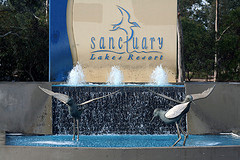 Sculptor Darryl Cowie's iconic wading bird's fountain In ancient Greece the vestibule was the open space between an entrance gate and the temple, main house or estate. Sanctuary Lakes Resort is fortunate to have its own natural vestibule of native trees from the entrance off Point Cook Road to the edge of the western end of the lake. The small woodland's amazing flora and fauna contains around a dozen different species of Australian native trees, ranging from sugar gums, peppermint gums, iron bark and cypresses through to acacias together with a variety of native grasses, low flowering bushes and of course countless species of birds. It would take a multi-paged pamphlet to describe fully the natural wonders of this small area, but for now let's look at two outstanding tree species, Red River Gums and Rosea Yellow Gums, a wonderful grass - Lomanda longiffolier and two birds - the Wattle (both the red and yellow) and the Galah.
Sculptor Darryl Cowie's iconic wading bird's fountain In ancient Greece the vestibule was the open space between an entrance gate and the temple, main house or estate. Sanctuary Lakes Resort is fortunate to have its own natural vestibule of native trees from the entrance off Point Cook Road to the edge of the western end of the lake. The small woodland's amazing flora and fauna contains around a dozen different species of Australian native trees, ranging from sugar gums, peppermint gums, iron bark and cypresses through to acacias together with a variety of native grasses, low flowering bushes and of course countless species of birds. It would take a multi-paged pamphlet to describe fully the natural wonders of this small area, but for now let's look at two outstanding tree species, Red River Gums and Rosea Yellow Gums, a wonderful grass - Lomanda longiffolier and two birds - the Wattle (both the red and yellow) and the Galah.
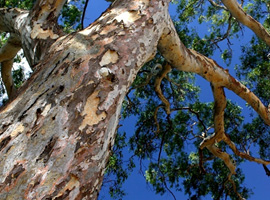 Red River Gum (Eucalyptus Camaldulensis) Coming off Point Cook Road and behind the Fountain with three of Darryl Cowie's captivating wading bird sculptures, stand over a dozen magnificent Red River Gums (Eucalyptus camaldulensis). The Red River Gums are the most widely distributed eucalyptus species in Australia growing along watercourses throughout the country. Our trees are 20' 25 m high and are able to grow to over 45 m, with a diameter of 1' 3 m. Although the entrance River Gums are the oldest trees on the estate at 60 to 70 years old, they are in fact mere toddlers for River Gums which can live up to 700 years. The trunk is vari-coloured, which includes patches of leaden grey bark above an area of brown-black. The canopy is dark green. They flower in the summer, in large bunches of small white to cream flowers, with a pungent nectar, attracting birds and bees alike. River Red Gums have a habit of dropping branches but the remaining limb hollows provide nesting berths for galahs, sulphur-crested cockatoos and various other parrots. These hollows in turn give the Red Gum a source of natural fertiliser from the feathered tenant's droppings.
Red River Gum (Eucalyptus Camaldulensis) Coming off Point Cook Road and behind the Fountain with three of Darryl Cowie's captivating wading bird sculptures, stand over a dozen magnificent Red River Gums (Eucalyptus camaldulensis). The Red River Gums are the most widely distributed eucalyptus species in Australia growing along watercourses throughout the country. Our trees are 20' 25 m high and are able to grow to over 45 m, with a diameter of 1' 3 m. Although the entrance River Gums are the oldest trees on the estate at 60 to 70 years old, they are in fact mere toddlers for River Gums which can live up to 700 years. The trunk is vari-coloured, which includes patches of leaden grey bark above an area of brown-black. The canopy is dark green. They flower in the summer, in large bunches of small white to cream flowers, with a pungent nectar, attracting birds and bees alike. River Red Gums have a habit of dropping branches but the remaining limb hollows provide nesting berths for galahs, sulphur-crested cockatoos and various other parrots. These hollows in turn give the Red Gum a source of natural fertiliser from the feathered tenant's droppings.
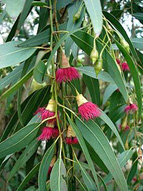 The Red Yellow Gum (Leucoxyion Rosea)
The Red Yellow Gum (Leucoxyion Rosea)
Leucoxyion Rosea or the commonly known Red Yellow Gum is a small to medium-sized strikingly colourful tree growing to 7-10 metres with rough bark on the lower third of the trunk. Above this, the bark becomes smooth with a white, yellow or bluish-grey surface. Adult leaves are a flat green in colour, stalked lanceolate shape and measuring up to 13 x 2.5 cm. It flowers profusely during winter and spring, with a spectacular intense crimson and pink flower. Like the Red Gum, it attracts a multitude of both birds and insects. Besides the flower's nectar being an essence for a gourmet honey, its leaves are distilled for the production of cineole based eucalyptus oil. Presently the Vestibule has three mature and four young Red Yellow Gums. They are already making a colourful presence but will become a truly impressive visual asset in the near future.
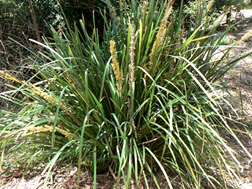 Spiky-head Mat-Rush or Basket Grass (Lomandra Longiffolia) Growing vigorously between the white and yellow iris (members of the Iridaceae family) is a gutsy bushy grass Lomandra Longiffolia, commonly known as Spiky-headed Mat-rush or Basket Grass. It is a perennial rhizomatous herb found throughout eastern Australia. The long grass-like leaves are 40 cm to 80 cm in length, quite thick and about 8 mm to 12 mm wide. It grows just about anywhere and is tolerant of frost, heat and drought. Indigenous Australians were known to grind the seeds into a form of flour for making dampers. Also they would use the long, flat, fibrous leaves for weaving mats, baskets and eel traps. The base of the leaves contains water and can be chewed by those in danger of dehydration.
Spiky-head Mat-Rush or Basket Grass (Lomandra Longiffolia) Growing vigorously between the white and yellow iris (members of the Iridaceae family) is a gutsy bushy grass Lomandra Longiffolia, commonly known as Spiky-headed Mat-rush or Basket Grass. It is a perennial rhizomatous herb found throughout eastern Australia. The long grass-like leaves are 40 cm to 80 cm in length, quite thick and about 8 mm to 12 mm wide. It grows just about anywhere and is tolerant of frost, heat and drought. Indigenous Australians were known to grind the seeds into a form of flour for making dampers. Also they would use the long, flat, fibrous leaves for weaving mats, baskets and eel traps. The base of the leaves contains water and can be chewed by those in danger of dehydration.
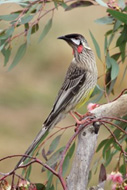 Red Wattle Bird (Anthochaera carunculata) If you ever have the good fortune to walk through this natural woodland at dawn, you would be amazed by the loud cacophony of bird noises, so loud that it often drowns out the sounds of traffic. There can be up to 20 different species of birds vocally contributing to the dawn chorus, but of course the loudest and dare I say, the least musical, is the battle between the Australian Raven and the Wattle Bird. The winner in the raucous and lack of melody category would be the Wattle Bird. There are two species of Wattle Bird in the vestibule woodland, the Red Wattle and the Little or Bush Wattle. The obvious difference is in their size. The Red Wattle Bird is one of the largest (around 28-30cms long) and most conspicuous of the honeyeaters. Attracted to the nectar of the eucalyptus, gums, banksias, cypresses and grevilleas, they are noisy and aggressive in defending their food sources. The name refers to the fleshy reddish wattle on the side of the neck. The plumage is grey-brown on the body, with prominent white and yellow streaks on the belly. The face is pale and the tail is long with a white-tip. They are easy to spot in flight by their white line on the fan of their tail feathers.
Red Wattle Bird (Anthochaera carunculata) If you ever have the good fortune to walk through this natural woodland at dawn, you would be amazed by the loud cacophony of bird noises, so loud that it often drowns out the sounds of traffic. There can be up to 20 different species of birds vocally contributing to the dawn chorus, but of course the loudest and dare I say, the least musical, is the battle between the Australian Raven and the Wattle Bird. The winner in the raucous and lack of melody category would be the Wattle Bird. There are two species of Wattle Bird in the vestibule woodland, the Red Wattle and the Little or Bush Wattle. The obvious difference is in their size. The Red Wattle Bird is one of the largest (around 28-30cms long) and most conspicuous of the honeyeaters. Attracted to the nectar of the eucalyptus, gums, banksias, cypresses and grevilleas, they are noisy and aggressive in defending their food sources. The name refers to the fleshy reddish wattle on the side of the neck. The plumage is grey-brown on the body, with prominent white and yellow streaks on the belly. The face is pale and the tail is long with a white-tip. They are easy to spot in flight by their white line on the fan of their tail feathers.
 The Little or Bush Wattle (Anthochaera chrysoptera) The Little Wattlebird as the name would imply is the smallest of the wattlebirds (23-25cms long). It is mostly dark grey-brown with white shafts on each of the feathers. The underparts are grey and heavily streaked with white. This gives it a speckled look. In flight, there is a large reddish patch that can be seen in their wings. The eyes are blue-grey. As with other honeyeaters, Little Wattlebirds feed mainly on nectar, which is obtained using its long, brush-tipped tongue, specially adapted to probing deep into flowers.
The Little or Bush Wattle (Anthochaera chrysoptera) The Little Wattlebird as the name would imply is the smallest of the wattlebirds (23-25cms long). It is mostly dark grey-brown with white shafts on each of the feathers. The underparts are grey and heavily streaked with white. This gives it a speckled look. In flight, there is a large reddish patch that can be seen in their wings. The eyes are blue-grey. As with other honeyeaters, Little Wattlebirds feed mainly on nectar, which is obtained using its long, brush-tipped tongue, specially adapted to probing deep into flowers.
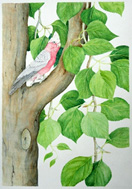 Rita Parkinson's painting of a Galah sitting between the distinctive leaves of a Chinese Poplar (Populus Simonil) residing on the South Boulevard lake side roundabout Although flocks of Galahs (Eolophus roseicapillus) have been seen around the Resort and in the woodland vestibule, particularly feeding off the seeds of the grasses on the roundabout and the median strips at the western edge of the lake, it is only recently that a few Galahs may have started breeding in the vestibule's River Gums. Galahs breed between July and November so we will have to wait for a few months to see if they have taken up River Gum tenancy permanently.
Rita Parkinson's painting of a Galah sitting between the distinctive leaves of a Chinese Poplar (Populus Simonil) residing on the South Boulevard lake side roundabout Although flocks of Galahs (Eolophus roseicapillus) have been seen around the Resort and in the woodland vestibule, particularly feeding off the seeds of the grasses on the roundabout and the median strips at the western edge of the lake, it is only recently that a few Galahs may have started breeding in the vestibule's River Gums. Galahs breed between July and November so we will have to wait for a few months to see if they have taken up River Gum tenancy permanently.
The Galah is one of the most abundant and familiar of the Australian parrots, occurring over most of Australia. It stands approximately 35 to 38 cm high. Its rose-pink head, neck and underparts are topped with a pale pinkie white "Mohawk". Their distinctive light grey back, wings and under tail, makes it easy to identify either in flight or as it demonstrates its comic walk while foraging on grass. The galah is a very social bird congregating in large flocks and can engage playfully with one another that supports the overall evidence of its very intelligent nature. They make a fairly high pitched "Chet Chet" type sound when flying around in the wild. But are also very good at impersonating everyday sounds such as a whistle, a horn or a telephone ringing. In their natural habitat the galah's average life expectancy is about 25 years.
As I said in the introduction, this is a small selection of the multi array of flora and fauna that can be seen in the vestibule woodland area. Now that the water reticulation is completed I am sure Greg Fryer and his Gardening team will be cultivating some surprises in the woodlands. A short stroll through or even a slowdown of your car, will give an enjoyable and fascinating experience. One small grumble, the gardeners tell me that at least 95% of the litter found in the woodland comes from McDonald's packaging. Come on Macca fans, lets save the litter for the bins.